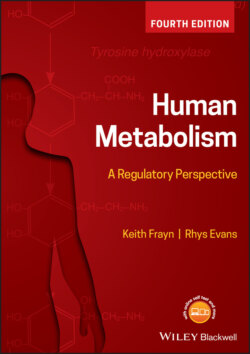Читать книгу Human Metabolism - Keith N. Frayn - Страница 47
1.3.4.2 Amino acid-nitrogen disposal
ОглавлениеDeamination of amino acids is achieved by two types of reaction which function in a complementary manner. The first is transamination, in which the amino group from one amino acid is transferred to another 2-oxoacid (carbon skeleton), forming its corresponding amino acid (i.e. amino acid-1 + 2-oxoacid-2 ↔ 2-oxoacid-1 + amino acid-2). The enzymes responsible for transamination reactions are aminotransferases (transaminases), all of which contain pyridoxal phosphate, a derivative of vitamin B6, in their active centres (Figure 1.20). Aminotransferases are widespread in most tissues and are near-equilibrium, and hence readily reversible. Each is specific for a limited number of amino acids, but most utilise 2-oxoglutarate (also called α-ketoglutarate) as the amino (N) acceptor (the ‘2-oxoacid-2’ in Figure 1.20), producing the carbon backbone of the donor amino acid together with glutamate (amino acid + 2-oxoglutarate → 2-oxoacid + glutamate). Hence 2-oxoglutarate and glutamate are central to amino acid catabolism as these reactions ‘funnel’ the various amino acids into glutamate (and note that 2-oxoglutarate is common to the TCA cycle, and its utilisation by this pathway depletes TCA cycle intermediates – cataplerosis). Alanine aminotransferase (ALT) transfers the amino group of alanine to 2-oxoglutarate, forming pyruvate and glutamate. The pyruvate can be used for gluconeogenesis (see below), e.g. during starvation. Alanine is a key transport form of amino acid carbon and nitrogen, hence this enzyme is important for inter-tissue amino acid flux. Aspartate aminotransferase (AST) transfers the amino group of aspartate to 2-oxoglutarate, forming oxaloacetate and glutamate – however, this enzyme usually works in the reverse direction, its function being to convert glutamate (derived from amino acid funnelling, above) into aspartate, which is required to donate a second urea N-atom to the urea cycle. Since ALT and AST are both intracellular enzymes and widespread, necrosis of many tissues, including liver, causes them to increase in plasma; they are commonly used to diagnose hepatocellular damage (so-called ‘liver function tests’).
Figure 1.20 Transamination reactions. Transamination involves the transfer of an amino group from the α-carbon of an amino acid to a recipient 2-oxoacid (α-ketoacid), forming its corresponding 2-oxoacid and generating an amino acid. These reactions are catalysed by aminotransferase enzymes, all of which are readily reversible. Although no net deamination occurs, these reactions allow the amino groups of all amino acids to be ‘funnelled’ into key amino acids prior to net deamination and hence metabolism.
The second type of reaction responsible for amino acid deamination is oxidative deamination. Since most amino acids have been funnelled (deaminated) into glutamate by transamination, glutamate is the only amino acid that undergoes direct, oxidative, deamination, by glutamate dehydrogenase, regenerating 2-oxoglutarate and producing ammonia (NH3). Unusually for a highly regulated enzyme, glutamate dehydrogenase is reversible, and can use NAD+/NADH or NADP+/NADPH as electron carriers. In the ‘forward’ direction of deamination (catabolic, amino acid breakdown), it uses NAD+, but in the ‘reverse’ direction of amination of 2-oxoglutarate to glutamate (anabolic, amino acid synthesis) it uses NADPH, reflecting the different roles of these cofactors as redox energy carriers in different metabolic states (Box 1.8; for simplicity, ionisation states are not always shown as they would be at physiological pH; ammonium ion shown here [NH4+] may be considered the same as ammonia). Hence, aminotransferases (transamination) and glutamate dehydrogenase (oxidative deamination) work together to produce ammonia for detoxification to urea in the urea cycle, and carbon skeletons for further intermediary metabolism (Figure 1.21).
Figure 1.21 Deamination of amino acids. By linking transamination reactions to oxidative deamination, and then to the urea cycle, all amino acids can be efficiently deaminated, their carbon backbones (2-oxoacids) going on to further metabolism for energy production, and the amino group being safely detoxified by the urea cycle.
